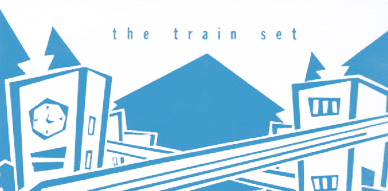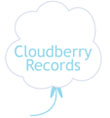
Thanks to David Hassall for the interview.
++ The only article I’ve ever found about The Train Set was on the Foxdude Records page and the information there is still not much. The only bit of information that strikes me is that the band was only around 1988 to 1990 according to it. Why did The Train Set last that little?
The Train Set were formed around 1985-86 as far as I’m aware, maybe earlier. I joined in 1986 when their singer Camel saw me playing at the college we both attended. I was on a music course and he was on a film course.
Basically the band lasted as long as they could release records, and then everyone just drifted off to other things. By then the original bass player had left to teach English in Brazil. I don’t think anyone heard from him ever again.
++ How and where did the band start? Who were the members? When and how you join the band? What was that thing in common amongst you that made the band work?
I think they started when they were at school together. The three main members were Camel, the singer (named after a character on a chocolate bar – his real name was Clive); Booty, an amazing and talented guitarist and Chiggy the bass player. They were all from Crewe, which is very relevant to the band name. They were joined by Adam Halford, left-handed drummer from a town called Winsford and myself, from Chester. So all in all, we were all from small provincial towns. They were about 23-24 when I met them, and I was 17. There wasn’t too much in common between the band with that particular line-up, and there was always friction between various members of the band, with the exception of Adam, who was by far the most organized of all of us.
++ All of your output was released on Playhard Records. I only know that the label also released a The Bodines 12″. Can you tell me a bit more about the label? How did you end up releasing with them?
Playhard was set-up by a renowned DJ from Manchester called Dave Haslam and Nathan McGough, the son of the Liverpool poet Roger McGough. There were a few bands on the label: The Bodines, King of the Slums, The Exuberants, Kit and The Train Set. Basically they were the only label that would have us! The original deal was made in the Cornerhouse cinema on Whitworth St in Manchester. From that we recorded a total of seven songs, all of which are available to listen to on Last.fm
++ 1988 sees the release of “She’s Gone”, which, I have read, got really good reviews. I also read that at the time 12″ singles weren’t that much appreciated. The Madchester fever was starting as well. What do you remember of those recording sessions and how the single was received?
We recorded “She’s Gone” in studio in central Manchester. I don’t remember much about it except it was in an old warehouse that could only be reached by a rickety old elevator. The main thing about that was just as we were leaving to go to the studio we couldn’t find Booty for hours, it turned out he had been arrested for suspected theft, a crime he was completely innocent of.
The rest of the tracks were recorded over in a studio called Slaughterhouse in Driffield, East Yorkshire. It was a bizarre place, one part of it was an old street that had been covered over and was used an ambient recording area. We arrived the week after the Happy Mondays had been recording there. They’d made quite an impression on the local night-clubs. The locals were still friendly with us in spite of this.
She’s Gone was released twice in the space of a few months, both times on 12″ which will have been to ensure the highest sound quality available at the time. The second time it was released it was named Single of the Week in the NME, which was quite an achievement at the time. It was marvelous to hear out on the radio and when people started singing along with all the tracks it all felt worthwhile.
It was then that the band made the move from their respective home-towns into Manchester. Camel lived in the building next door to Tim from James. He used to pop round occasionally. We actually ended up as second support on tour with them and the Happy Mondays.
++ One year later you release “Hold On”, another 12″. Do you feel the band was going in the same direction as in the first single? Were you all happy with the final result of your singles?
I think all the tracks on the second EP were really good, the only thing was the track order. Because of the subject nature of “Hold On” it was felt that that should be the ‘a’ side, when really ‘Harped on ‘ should have been. It was a much more positive track which really worked live as well. It’s just one of those things that you wished you’d done differently in hindsight.
++ Where there more recordings from the band? Maybe some demos that have been totally forgotten? A retrospective release would be amazing, you know ![]()
I’m afraid there are no other recordings I’m aware of. We did have a set of around an hour and a half, so there was more material, we just never got the opportunity to record it. The thing I remember most is our encore versions of “Miss you” by the Rolling Stones, and the theme from the Love Boat, which really used to throw a standard indie crowd.
++ How would you describe The Train Set sound? What were the bands that influenced you?
The key influences for the band were the same as everybody at the time – The Smiths and The Bunnymen. Personally I can’t stand The Smiths, but I worship The Bunnymen. The rest of the band really liked The Smiths, but I just didn’t get them. Beyond that the main musical input was from Booty, who was an amazing guitarist, with a completely natural musicality. We used to spend hours working out the minutest detail. We probably overworked the material, but the tightness of the band was a key element to the whole sound. There was nothing we’d recorded we couldn’t produce live from the same line-up.
++ Did The Train Set play many gigs? any particularly special gigs that you remember?
We gigged extensively on the college circuit, and did two UK tours firstly supporting James, with the Happy Mondays, and then subsequently supported the Mondays on the Bummed tour. That was an experience. Although not as chaotic as you might think. We knew the Mondays quite well as our Manchester rehearsal space was next door to theirs, under a local venue called “The Boardwalk” on Little Peter Street.
One particularly memorable gig for me was at the Astoria on Charing Cross Road in London. Everything just went perfectly, it was the best we’d ever sounded and the audience really enjoyed us. Of course playing at the Hacienda was especially good, it was such an important place, although the sound was always awful there. It was just the wrong shape. The best audience ever was in Norwich, after the gig we were taken around a variety of parties, ending up on an isolated farm in the middle of nowhere wondering where the hell we were and how we’d go there.
We did play some shocking venues as well, I never liked playing Dingwalls in Camden, especially after an altercation with the bouncers during a gig with My Bloody Valentine. Again in Camden I remember playing a venue called the Greyhound. We were headlining and being supported by the Milltown Brothers. There was a really good audience for them, but as soon as we came on the place emptied. Completely. That was a long and miserable 250 mile drive home through the night.
++ Were you involved with any bands before or after The Train Set?
Whilst working with the Train Set I was also starting to get involved with session work and engineering. As the band drifted apart I worked with My Jealous God playing keyboards for their UK tour. After that I worked on more and more dance material, releasing white labels under a range of names, with a variety of singers – the one I’m most proud of is “Quiet Child” by The Sound Foundation. I also worked on remixes for bands like The Christians (The Bottle & DMC remixes of Forgotten Town), and some did some session work with K-Klass, rewriting and playing the main keyboard lines for their remix of Bobby Brown’s “Two Can Play That Game”.
++ Why do you think that during those late eighties there was an explosion of pop kids playing guitar pop? What do you think was the main catalyst for this to happen?
Thinking back to the time, The Smiths and The Bunnymen were a complete breath of fresh air for many people. I think there was a backlash against dance-orientated music at the time. It was all rather lame, just waiting for Acid House to emerge. That what was so interesting about Manchester at that moment, as it was really a crossover between the two genres.
++ What was the best of being part of The Train Set?
Being on the road could be fun, but waiting around for them after the gigs had finished was not. They had a great enthusiasm for enjoying themselves wherever they could, but somebody had to make sure the equipment was safe. It was great to see the songs you’d written being enjoyed by the crowd. That was just what it was all about.
++ Are you still in touch with your fellow The Train Set members? Do you know why the band was called like that?
I haven’t seen any of them for at least 10 years, although I did bump into one of the roadies at Crewe Railway Station a couple of years back. I don’t think he was pleased to see me – we’d never got on. I don’t really know what they’re up to now. I just hope they’re happy.
The name of the band is a cheesy pun based on the fact that the home town of the band, Crewe, is essentially one giant railway junction serving the whole of the north of the UK. That was it, nothing more meaningful at all.
++ Thanks so much! Anything else you’d like to tell the independent pop world out there?
It’s been a pleasure. The only thing left is to quote the great Viv Savage “Have a good time, ALL the time”.
::::::::::::::::::::::::::::::::::::::::::::::::::::::::::::::::::::::::::::::::::::::::::::::

